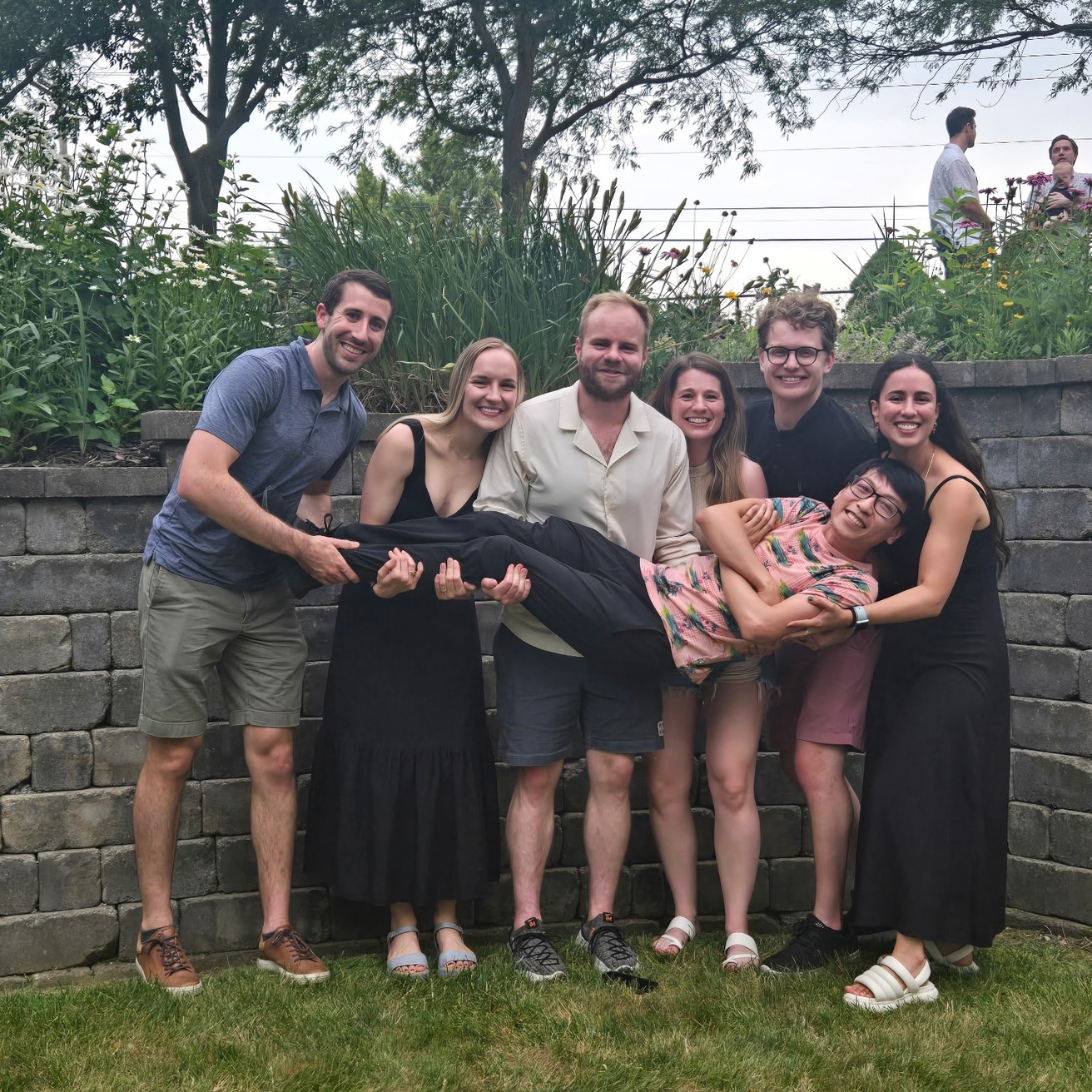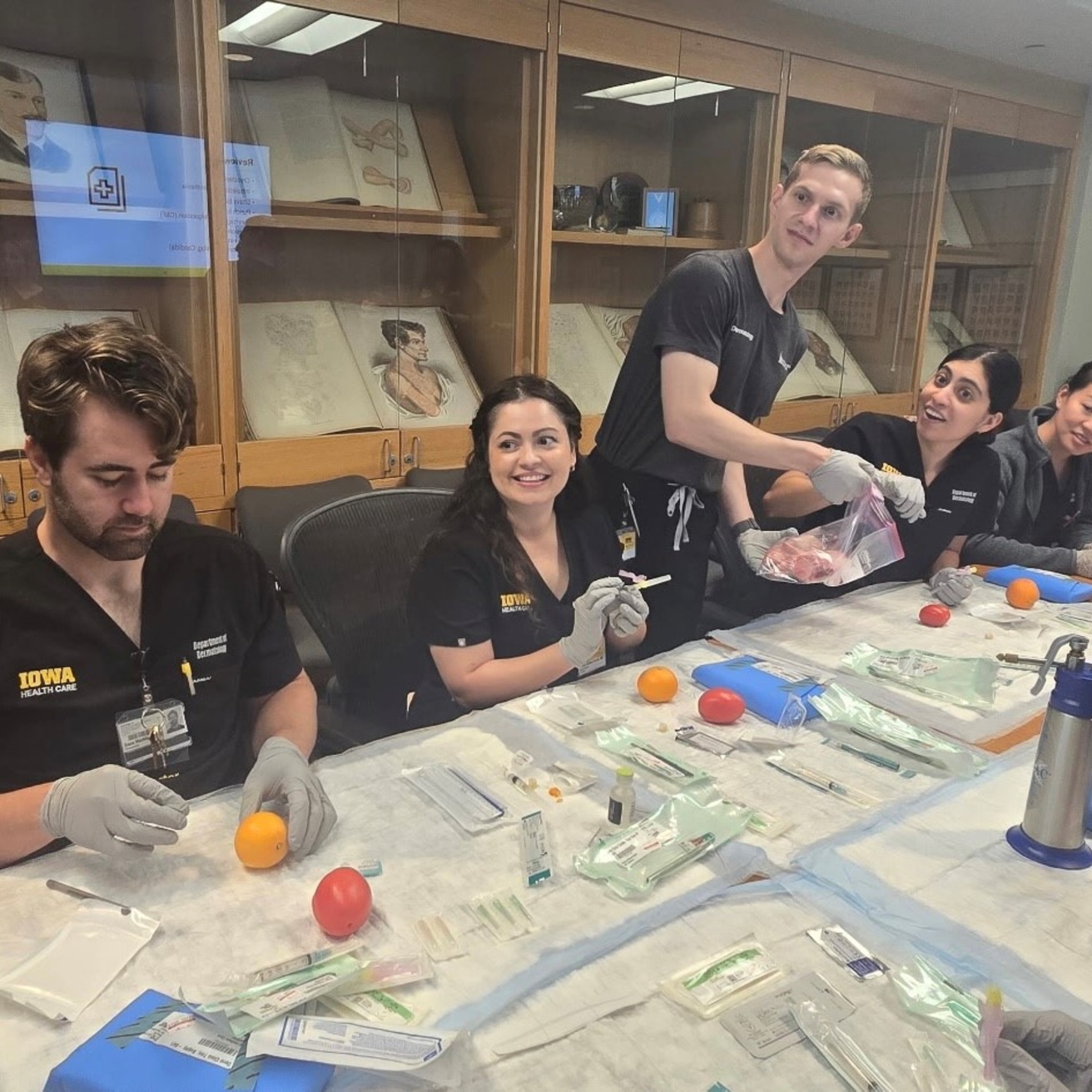Main navigation
The Residency Training Program in Dermatology at University of Iowa Health Care spans three years. Within the training program, each trainee is exposed to immersive clinical and didactic experiences in a manner to promote skill development along a trajectory that culminates in the autonomous practice of dermatology.
Clinical Experiences
With regards to clinical rotations, our program utilizes an integrated block scheduling structure with active clinical experiences that vary over each week, each month, and each year of training. There are no dedicated block rotations longer than 10 weeks’ duration. In any given year of training, the clinical experiences are organized as a form of spaced education, where shorter educational encounters are spaced and repeated over time, with the goal of increased learning efficiency and improved retention. Moreover, the sequence of clinical experiences as organized over the three years of the program are designed as a spiral curriculum intended to produce graduates who have achieved competency in clinical practice of the four core areas of dermatology: (i) dermatologic surgery, (ii) Mohs, and cosmetics; dermatopathology; (iii) medical dermatology (adult and pediatric); and (iv) inpatient dermatology. The goals and objective for each of these four core clinical experiences are described in later sections of this handbook.
Training Year #1
First year-residents are primarily assigned to rotating general outpatient adult and pediatric dermatology clinics at the UI Health Care university campus clinics (Pomerantz Family Pavilion clinic and Stead Family Children’s Hospital specialty clinic) and the UI Health Care Iowa River Landing clinic. Clinic assignments change on a weekly basis to allow exposure to our various specialty outpatient clinics (skin of color clinic, immunobullous disease clinic, hair loss clinic, cutaneous lymphoma clinic, pediatric specialty clinic, etc.). After the first three months of training, first-year residents begin intermittent assignments to general dermatology clinics at the Iowa City VA Medical Center (VAMC). All first-year residents are assigned to a UI Health Care continuity clinic that takes places at least twice monthly throughout the entirety of their three years of training. In addition to these general dermatology clinics and specialty clinics, our first-year residents are also intermittently assigned to various procedure clinics at the UI Health Care university campus clinics, the UI Health Care Iowa River Landing clinic, and the Iowa City VAMC. In these clinics, residents gain experience in performing excisions, curettage & fulguration, various laser therapies, and basic cosmetic procedures. In the second half of the first year of training, our residents complete a dedicated 3- or 4-week block on the UI Health Care dermatopathology service. First-year residents have no night or weekend call responsibilities.
Training Year #2
During the second year of training, residents continue rotating assignments to our general dermatology clinics, specialty clinics, continuity clinics, and procedure clinics as described for first-year residents. In promotion of their graduated autonomy, second-year residents now manage patients with indirect supervision while working in clinics at the Iowa City VAMC. Second-year residents also complete a dedicated 3- or 4-week rotation on the UI Health Care dermatopathology service. In addition to these core assignments, second-year residents further develop their skills by completing separate dedicated 5- to 7-week rotations on the UI Health Care inpatient consult service and a 10-week rotation on the Mohs surgery service. While rotating on the inpatient consult service, residents manage adult and pediatric patients in the various inpatient wards and emergency departments of the UI Health Care university hospital and the UI Health Care Medical Center Stead Family Children’s Hospital. The inpatient consult service resident is responsible for triaging inpatients and outpatients with acute dermatologic concerns via telephone consultations with external dermatology and non-dermatology providers, often aided by electronic images of the associated skin concerns. The inpatient consult service resident is responsible for night call coverage on Monday through Thursday nights. Weekend call and coverage of the inpatient consult service is assigned to the members of the second-year resident class on a rotating basis. The Mohs surgery experience includes excision of Mohs tissue layers, histopathologic review of frozen sections, and the design and execution of complex linear closures, flaps, and grafts. The consecutive 10-week experience provides residents with the longitudinal continuity to follow reconstruction outcomes until complete maturation. Mohs experiences occur in the UI Health Care Pomerantz Family Pavilion dermatology clinic, the Mohs clinic at the Iowa River Landing clinic, and the Iowa City VAMC.
Training Year #3
During the third and final year of training, residents continue rotating assignments to general dermatology clinics, specialty clinics, continuity clinics, and procedure clinics as described for first- and second-year residents. Third-year residents are also intermittently assigned to the Mohs surgery service. Third-year residents will complete an additional 2- to 3-week dedicated rotation on the UI Health Care inpatient consult service, along with an additional 4- to 5-week dedicated rotation on the dermatopathology service. Unique to the third year of training, each resident will serve 7 to 10 weeks as the VA chief resident. As the highest level of graduated autonomy, under indirect supervision, the VA chief resident is responsible for the entire clinical service at the Iowa City VA Medical center, including management of all follow up for patients seen in the outpatient clinics, the fielding of all incoming patient concerns via telephone call or electronic secure messages, and all inpatient and emergency department consults. Third-year residents have the opportunity to take up to 4 weeks of clinical service time to pursue elective research or elective clinical experiences. With regards to elective clinical experiences, residents can rotate one or more weeks within a number of different clinical specialty clinics at UI Health Care, including rheumatology, infectious disease, allergy/immunology, pediatric rheumatology, pediatric allergy/immunology, oculoplastics, surgical pathology, and vulvar disease, to name a few. Residents can also elect to work as a locum tenens dermatology provider (1 week maximum), or spend additional weeks on the UI Health Care Mohs surgery service, the inpatient dermatology service, or the dermatopathology service. Residents can use clinical elective time to attend one additional clinical dermatology conference, upon approval from the Program Director, and paid for by the resident. External electives at off-campus locations that provide educational experiences not available within the context of our training program (e.g., tropical medicine) can be arranged pending approval of the Program Director and the UI Health Care GME office.
First Year (PGY-2)
- UIHC clinics (adult and pediatric)
- Procedure clinics (excisions, lasers)
- UIHC continuity clinics
- VA clinics
- Dermatopathology (3 weeks)
- No night or weekend call
Second Year (PGY-3)
- UIHC clinics (adult and pediatric)
- VA clinics
- Procedure clinics (excisions, lasers, cosmetics)
- UIHC continuity clinics
- Mohs surgery rotation (10-11 weeks)
- Dermatopathology (3 weeks)
- Inpatient consults/weekday night call (6-8 weeks)
- Weekend call (10-11 weekends)
Third Year (PGY-4)
- UIHC clinics (adult and pediatric)
- VA clinics
- VA chief resident
- Procedure clinics (excisions, lasers, cosmetics)
- UIHC continuity clinics
- Dermatopathology (3-4 weeks)
- Inpatient consults/weekday night call (3-5 weeks)
- Electives (4 weeks)

